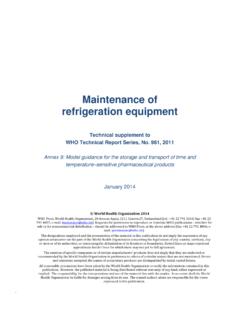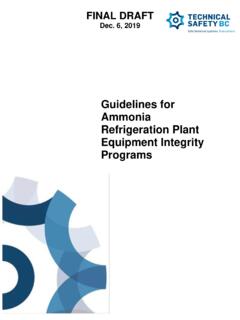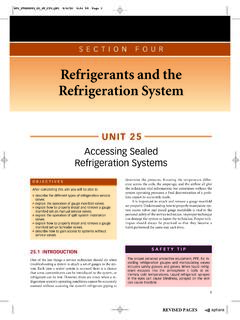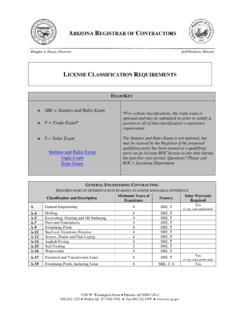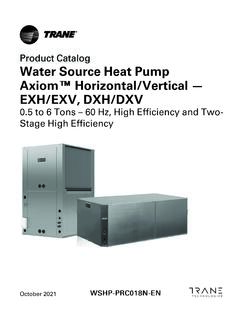Transcription of Industrial Refrigeration Best Practices Guide iii
1 Industrial Refrigeration Best Practices Guide iii Table of Contents Table of Contents List of Figures .. vi List of Tables .. viii CHAPTER 1 Introduction .. 1 Background .. 1 Goals .. 1 Focus on Industrial Refrigeration .. 2 Overview of this Best Practices Guide .. 3 CHAPTER 2 Best Practices Overview .. 5 The Scope of Refrigeration Best Practices .. 5 Life-Cycle Costs .. 5 Energy Efficiency The Big Picture .. 6 How to Implement Best Practices .. 6 Benefits Beyond Energy .. 8 CHAPTER 3 Refrigeration System Basics .. 9 Introduction .. 9 Purpose of Refrigeration .. 9 Refrigerants .. 9 Refrigerant Phases .. 10 Air Dry-Bulb and Wet-Bulb Temperatures .. 10 Basic Refrigeration Cycle .. 11 Evaporation .. 11 Compression .. 11 Condensing .. 11 Expansion .. 12 Two-Stage Cycle .. 12 Refrigeration equipment .. 12 Evaporators .. 13 Compressors .. 21 Condensers .. 32 Vessels, Pumps, Valves, Purgers, and Underfloor Heating .. 35 Controls .. 40 Variable Frequency Drives (VFDs).
2 44 CHAPTER 4 Best Practices for equipment , Systems, and Controls .. 49 Introduction .. 49 Reducing 49 Introduction .. 49 Increasing Suction Pressure .. 49 Reducing Discharge Pressure .. 52 Barriers to Reducing Minimum Condensing Pressure .. 55 Improving Part-Load Performance .. 58 Introduction .. 58 iv Industrial Refrigeration Best Practices Guide Table of Contents Improving Evaporator Part-Load Performance .. 58 Improving Compressor Part-Load Performance .. 62 Improving Condenser Part-Load Performance .. 65 Upgrading equipment .. 68 Introduction .. 68 Evaporator Coil Efficiency .. 68 Compressor Efficiency .. 70 Condenser Efficiency .. 72 Premium-Efficiency Motors .. 74 Motor Sizing .. 74 Improving System Design .. 74 Introduction .. 74 Multistage Compression .. 75 Liquid Subcooling .. 76 CO2/Ammonia Cascade Systems .. 76 Gas-Pressure Recirculation Systems .. 76 Defrost .. 77 Heat Recovery .. 79 Purgers .. 80 Reducing Refrigeration Loads .. 81 Introduction.
3 81 Building Upgrades .. 81 Process Upgrades .. 83 Computer Control The Backbone of 84 Efficiency Checklist .. 85 What Makes a Compressor Efficient? .. 86 What Makes an Evaporator Efficient? .. 87 What Makes a Condenser Efficient? .. 88 CHAPTER 5 Best Practices for O&M and Commissioning .. 89 Introduction .. 89 Operation and Maintenance .. 89 Introduction .. 89 Evaporators .. 90 Compressors .. 90 Condensers .. 91 Commissioning .. 92 Introduction .. 92 Relationship Between Refrigeration Commissioning, Energy Commissioning, and O&M .. 93 Evaporators .. 93 Compressors .. 94 Condensers .. 94 System and Vessels .. 94 Refrigeration Loads .. 95 Controls .. 95 CHAPTER 6 Tools for Implementing Best Practices and Energy Management .. 97 Introduction .. 97 Why Improve How You Manage Energy? .. 97 Industrial Energy Management Strategies .. 98 Elements of a Successful Energy Management Program .. 98 Industrial Refrigeration Best Practices Guide v Table of Contents Industrial Refrigeration Key Performance Indicators.
4 99 System Assessment Questionnaire .. 101 Estimating the Annual Energy Cost of Your Refrigeration System .. 112 Using an Energy Study as a Management Tool .. 114 Energy Accounting .. 116 Information Sources for Industrial Refrigeration .. 118 APPENDIX A Hot-Gas Defrost .. 119 A Typical Configuration .. 120 Cooling Mode .. 121 Pump-Down Phase .. 122 Hot-Gas Phase .. 123 Bleed-Down 126 Refreeze Phase .. 126 APPENDIX B Case Studies .. 129 Industrial Refrigeration Best Practices Guide 1 Chapter 1: Introduction CHAPTER 1 Introduction Courtesy of Frick Background This Guide identifies and discusses best Practices for making Industrial Refrigeration systems both energy-efficient and productive. The highest levels of efficiency in these systems are achieved through a combination of design, construction, commissioning, operation, and maintenance coupled with a robust energy management program. This Guide provides insights into approaches to Industrial Refrigeration systems that cost less to operate, are reliable, can maintain accurate and consistent temperatures in refrigerated spaces, help ensure that processing equipment operates consistently, and can meet varying production needs.
5 This Guide targets the full range of interested, influential, or affected parties associated with Industrial Refrigeration . This includes system operators, maintenance staff, design engineers, Refrigeration contractors, equipment vendors, production staff, management, and owners. After reading this Guide , it should be possible for anyone in this list to have a substantive and productive discussion about improving the performance of Refrigeration systems. This Guide contains a minimum of formulas, thermodynamic diagrams, and technical detail just enough to achieve a common understanding and appreciation that enables real continuous improvement. The focus is real-world situations and solutions, not academic pursuit. Goals Ultimately, improving energy efficiency in Industrial Refrigeration is achieved by changing the business Practices of food-processing companies, cold-storage and refrigerated warehouses, and the trade allies that support and serve them.
6 Design standards and operation-and-maintenance Practices that increase and maintain energy efficiency can also be adopted by users of Industrial Refrigeration and their engineering consultants and contractors. In this context, the goals of this Best Practices Guide are: To identify opportunities to increase electrical energy efficiency in Industrial Refrigeration systems The Guide specifically focuses on energy savings measured in kilowatt-hours (kWh). It is written primarily for audiences where energy costs are the largest portion (usually over 80%) of typical 2 Industrial Refrigeration Best Practices Guide Chapter 1: Introduction electric bills. The Guide does not specifically address reducing peak monthly power demand, measured in kilowatts (kW). However, in most cases, a system that saves energy will also reduce peak demand. This Guide also does not address load-shifting strategies, where Refrigeration load is shifted from a high-cost time period to a low-cost time period, nor does it address reactive power (power factor, or kVAR) or power-quality issues such as harmonics.
7 To better understand Industrial Refrigeration as a system Energy efficiency in Industrial Refrigeration includes both selecting efficient components and integrating those components into an efficient system. The goal is to minimize the energy consumption of the entire system. Frequently, one or more small constraints in a system can limit the efficiency of the overall system. In other instances, reducing the energy use of one type of component may increase the energy use of another. Understanding the way the system behaves as a whole lets us avoid building in weak links and allows us to strike an efficient balance between components. To motivate system designers, contractors, plant engineers, and owners to consider life-cycle costs when installing or upgrading Industrial Refrigeration systems The equipment -supply and design-build businesses are very cost-competitive, and facility owners have limited capital budgets. Therefore, system design often emphasizes low initial cost rather than low life-cycle cost.
8 Energy costs are the most significant ongoing life-cycle cost, and are a major component of the total present-value cost of a Refrigeration system. To highlight non-energy benefits of energy-efficient Practices In most situations, investments in energy efficiency can also reduce labor costs, increase productivity, increase product quality, and increase system reliability. To emphasize that best Practices include more than just system design Commissioning and well considered operation-and-maintenance Practices contribute importantly to the long-term energy performance of the system. Encourage facilities to implement a robust energy management program A successful energy management program allows a facility to sustain and improve upon the efficiency benefits that have been achieved. Key elements of a successful energy management program include establishing an Energy Champion that is accountable for system energy use, tracking Key Performance Indicators (KPIs) of system efficiency, ensuring that key personnel receive appropriate training, and creating a culture that embraces a continuous improvement philosophy towards energy efficiency.
9 Focus on Industrial Refrigeration This Guide focuses solely on Industrial Refrigeration systems, which we define in the following broad terms. Table 1: Qualifying attributes of Industrial Refrigeration systems Attribute Criteria Size: 100 tons or larger Refrigerant: Ammonia (R-717) in the vast majority of cases, with some R-22 applications System Type: Centralized and built-up, as opposed to commercial Refrigeration equipment , which is simpler, more modular, and distributed Load Temperatures: -60 F to 55 F with normally at least one load below 40 F Function: Primarily storage and processing of food products Industries: Refrigerated warehouses, including controlled atmosphere Fruit and vegetable processors, ranging from fresh product storage to highly processed pre-prepared meals Breweries and wineries Dairy and ice cream processors Meat, poultry, and fish processors Industrial Refrigeration Best Practices Guide 5 Chapter 2: Best Practices Overview CHAPTER 2 Best Practices Overview The Scope of Refrigeration Best Practices This chapter addresses best Practices for energy efficiency from a management level.
10 We introduce four interrelated concepts that contribute to good business decisions. Best Practices should encompass design, operation, maintenance, and commissioning. Attention to all of these activities will optimize overall system performance. Design Designing the facility to reduce loads Selecting energy-efficient equipment and controls Integrating that equipment into a system that is optimized for efficiency at both peak and typical loads Operation Trained and certified operators with a conceptual knowledge of energy-efficient Practices and an understanding of Refrigeration cycles Scheduled or regular review and documentation of key set points and operational strategies required for energy-efficient operation Using a control system to review operations to confirm efficient operation and to automate complex control strategies Observing equipment and gauge readings to confirm efficient operation Maintenance Trained and certified maintenance staff and contractors Preventive maintenance Practices Routine calibration of sensors, controls, and actuators that indicate system performance Routine cleaning and maintenance of evaporators.
